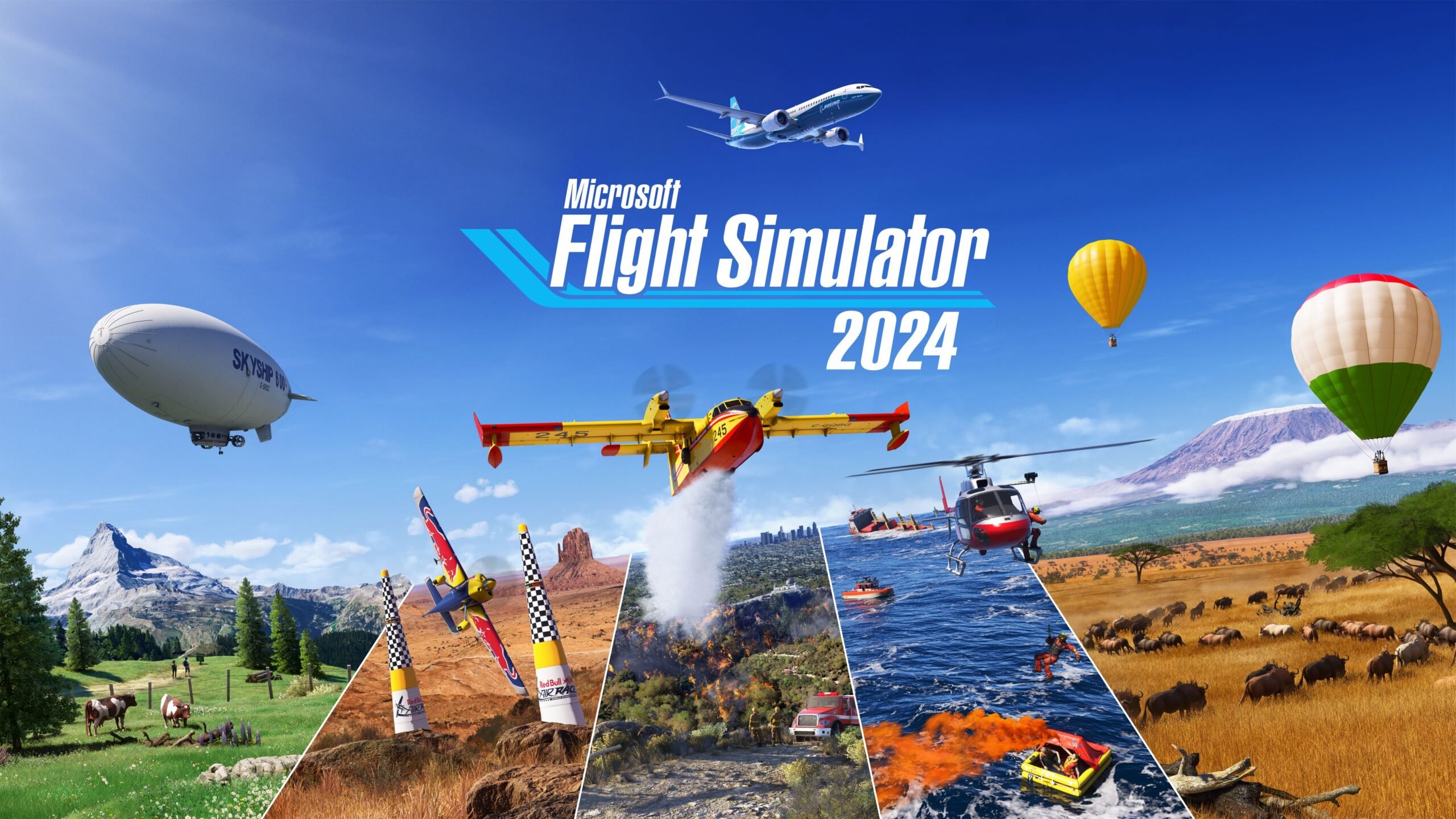Microsoft Flight Simulator continues to prove why it’s the gold standard for civilian aviation sims—pushing visuals, flight models, and immersion forward at a blistering pace. The past few weeks have delivered a flood of announcements and releases that touch nearly every corner of the ecosystem, from official world updates to third-party audio overhauls.
Whether you’re flying in the legacy 2020 platform or the newer 2024 edition, there’s plenty of fresh content to explore right now—and even more on short-final.
SoFly’s FlightSimExpo Announcements
| Add-On | Planned Release | Why It Matters |
|---|---|---|
| Cabin Announcement Pro | Q1 2026 | Brings dynamic, airline-style safety briefings, boarding music, and multi-language announcements that react to your flight phase. A built-in control panel lets you customize carrier branding and voice packs so every livery feels authentic. |
| Bristol Airport (EGGD) | Q3 2025 | Built after extensive on-site photogrammetry, this scenery includes custom ground clutter, animated landside traffic, and ambient terminal audio. Ideal for short-haul routes to Europe or as a GA base in the West Country. |
| Aircraft Sound Enhancer | Summer 2025 | Injects 500+ positional sound effects—icing rattles, canopy wind-blasts, tire scrubs—triggered by live sim variables. Profiles ship for popular airframes, and a node-based editor means you can tailor audio to payware aircraft. |
SoFly also confirmed that each of these products will ship with native installers for MSFS 2020 and MSFS 2024, ensuring forward compatibility as simmers transition to the newer platform.
Official Microsoft & Asobo Studio Updates
City Update 11 – Northeastern US 2
Released July 3 2025, this package refreshes Boston, Providence, Hartford, Philadelphia, and Atlantic City with laser-scanned landmarks, improved coastline meshes, and accurate night lighting. Pair it with a rainy live-weather approach into Logan and the new skyline feels stunningly lifelike.
Famous Flyer 12 – Piper PA-28-236 Dakota
A faithful recreation of the 235-hp variant beloved by real-world trainers. Highlights include realistic Johnson-bar flaps, carb-ice modeling, and performance numbers that line up with POH data. It’s an ideal step-up aircraft between the Cherokee and a complex retractable.
Sim Update 3 – On Short-Final
While Asobo is holding back the full change-log, early developer build notes point to:
- Performance: Further threading optimizations for CPU-limited systems and better VRAM management on high-resolution textures.
- Atmospherics v2.1: Tweaked turbulence decay, smoother ridge lift, and new microburst logic tied to METAR thunderstorm cells.
- Avionics Framework: Adds navigraph-style charts API hooks and improved touchscreen latency, paving the way for third-party G3000 and ATR upgrades.
- Mission Tools: A revamped bush-trip editor that lets creators layer custom voice-overs and branching objectives.
Release timing hasn’t been nailed down, but public testing is expected within weeks—so keep an eye on the in-sim Marketplace beta banner.
Why These Updates Matter for Simmers
- Deeper Immersion
- Realistic cabin chatter and reactive soundscapes blur the line between desktop and flight deck, especially in VR.
- High-fidelity regional scenery turns mundane IFR training flights into sightseeing tours.
- New Aircraft Workflows
- The Dakota’s manual mixture and constant-speed prop give beginners a gentle introduction to complex-prop management before hopping into turboprops.
- Updated avionics hooks promise smoother integration with physical hardware and tablet EFBs.
- Sharper Performance Across Platforms
- Threading tweaks target stutters on dense photogrammetry loads—crucial for Xbox Series S users flying into PACKED hubs like Philadelphia.
- The upcoming atmospheric refinements should reduce the “roller-coaster” turbulence some users reported after the last CFD update.
- Future-Proofed Content
- SoFly’s dual-platform installers eliminate the headache of repurchasing favorite add-ons once you migrate fully to MSFS 2024.
- Asobo’s mission-tool overhaul finally gives community creators the flexibility to build branching training scenarios and narrative adventures—exactly the kind of content Microsoft teased for its upcoming “Exploration” campaign series.
Getting Ready for Takeoff
If you’ve been away from the sim for a few months, now is the perfect time to update, reload, and revisit your hangar. Grab City Update 11 for free through the in-sim Marketplace, fire up a Dakota checkout flight from Providence to Nantucket, and listen as Cabin Announcement Pro’s crew welcomes passengers in authentic New England twang. Then keep an ear to the ground—Sim Update 3 is likely to touch down soon, bringing another round of performance boosts and depth to what is already the most ambitious civilian flight sim ever released.
Microsoft Flight Simulator 2024
Microsoft Flight Simulator 2024 is raising the bar for virtual aviation enthusiasts with its enhanced graphics and features. The game demands powerful hardware to deliver its immersive experience, especially for pilots who want to explore the skies in high resolution. Microsoft Flight Simulator 2024 requires at minimum a 64-bit Windows 10 operating system, an AMD Ryzen 7 2700X or Intel Core i7-10700K processor, and 32GB of RAM to run properly.
The system requirements show a significant increase from the 2020 version, particularly in memory needs. Many gaming PCs built for earlier flight simulators may need upgrades to handle this latest release from Asobo Studio. Graphics requirements are equally demanding, with cards like the AMD Radeon RX 5700 XT recommended for optimal performance.
For serious flight sim fans, investing in hardware like the popular Ryzen 9 7900X or 7800X3D processors might be worth considering. These CPUs have become community favorites for running flight simulators smoothly, especially when paired with adequate RAM and graphics power.
Microsoft Flight Simulator 2024 is the latest installment in the popular flight simulation franchise, developed by Asobo Studio and published by Xbox Game Studios. It was released on November 19, 2024, for Windows and Xbox Series X/S, and was available day one on PC Game Pass and Xbox Game Pass Ultimate.
Here’s a breakdown of what makes it stand out:
Key Features and Improvements:
- Enhanced “Digital Twin” Earth:
- Unprecedented Detail: The game significantly improves the visual representation of Earth, with a 4,000-factor increase in ground detail. This includes 3D modeled small stones, rocks, gravel, and grass, impacting how aircraft wheels interact with surfaces.
- Advanced Photogrammetry: Over 500 Triangular Irregular Network (TIN) cities and more than 100,000 square kilometers of countryside photogrammetry provide stunningly realistic digital twin experiences.
- Populated World: A richly diverse and regionally accurate representation of humanity brings life to airports, aircraft, and passenger cabins. Real-time ship tracking allows you to see cargo ships moving globally, and you can even see passengers inside airliners.
- New Environmental Elements: For the first time, the sim includes helipads, glider airports, and oil rigs worldwide. It also introduces domesticated animals like cows, sheep, goats, and horses across the planet.
- Improved Weather and Lighting: The all-new photometric lighting system renders the world more accurately. Enhanced weather features include new cloud types, auroras, and other atmospheric phenomena. Seasons are also accurately depicted, with dynamic foliage changes and even tracks in snow.
- Deep Career Mode:
- Fly with Purpose: This is a major addition, allowing simmers to pursue an aviation career with a variety of missions and objectives.
- Diverse Activities: Missions range from Medevac, Remote Cargo Ops, Aerial Firefighting, Search & Rescue, VIP charter service, air racing (including Red Bull and Reno Air Races), and even becoming an Airline Passenger Transport Pilot.
- Skill Progression: The career system includes pre-flight procedures, logging flight paths, and a certification tree to learn skills for various aircraft types. You can gain experience and build your reputation, with specialized paths unlocking different mission types.
- World Photographer Mode: Unique photo challenges test both piloting and creative skills as you capture natural vistas and famous landmarks.
- Advanced Simulation:
- Enhanced Physics: An improved physics system supports over 10,000 rigid-body surfaces, enabling realistic simulation of any aircraft shape. Soft body physics for elements like cloth, ropes, and balloons (e.g., hot air balloons) add another layer of realism. Improved ground and water handling further enhance realism.
- Detailed Aircraft Systems: New, highly accurate aircraft systems are modeled, including electrical, pneumatic, fuel, and hydraulic systems, payload and passenger systems, and advanced avionics like the Universal UNS-1 FMS and Honeywell Primus Epic 2. Preflight inspections and walkaround checks add to the immersion.
- Ground Exploration: For the first time, you can land anywhere and exit your aircraft to explore 27 highly detailed biomes with hundreds of species of vegetation, dynamically created details like grass, rocks, and flowers.
- Improved Flight Planning: A groundbreaking flight planner supports both IFR and VFR map layers, IFR charts, route planning, fuel and payload planning, vertical profile planning, and ETOPS planning. It also provides airport information, including weather and NOTAMs, and is accessible in-sim, on mobile devices, or via web browsers.
- Technical Advancements:
- Smaller Installation Size: By leveraging cloud streaming technology, the initial installation size is trimmed down to about 30 GB, with higher-detailed areas streaming in as needed (though a full download option is available, which can be over 400 GB).
- Improved Performance (with caveats): While aiming for better overall performance, some alpha testers reported initial memory leaks and performance issues, which are expected to be optimized.
- Faster Load Times: Significant improvements in load times compared to Microsoft Flight Simulator (2020) were noted in alpha tests.
- Updated UI: A cleaner, more modern user interface.
- Better Sound Design: Enhanced ambient sounds contribute to a more immersive airport experience.
- AI Traffic Improvements: Work has been done on AI traffic behavior, especially on the ground, to reduce traffic jams and improve runway entry/exit.
Important Notes:
- Microsoft Flight Simulator 2024 is a standalone simulator and the next-generation sequel to Microsoft Flight Simulator (2020).
- Current aircraft and airports from MSFS (2020), as well as most Marketplace add-ons, are intended to be supported in MSFS 2024.
- The game is designed to take advantage of the latest technologies in simulation, cloud, machine learning, graphics, and gaming.
In essence, Microsoft Flight Simulator 2024 aims to be the most ambitious and immersive flight simulator yet, expanding beyond just flying to include a comprehensive career system and an even more detailed “digital twin” of Earth.
Key Takeaways
- Microsoft Flight Simulator 2024 requires 32GB RAM, a powerful CPU, and runs only on 64-bit Windows 10 systems.
- The game’s hardware requirements represent a significant jump from the 2020 version, potentially requiring upgrades for many users.
- Community consensus suggests AMD Ryzen 7800X3D processors deliver excellent performance for serious flight simulation enthusiasts.
System Requirements Overview
Microsoft Flight Simulator 2024 has specific hardware demands to run smoothly. These requirements vary depending on whether players want basic functionality or a premium experience with high-resolution graphics and detailed environments.
Minimum Specifications
To run Microsoft Flight Simulator 2024, users need at least Windows 10 operating system with DirectX 12 support. The minimum CPU requirement is an AMD Ryzen 5 or Intel i5 processor. For graphics, an NVIDIA GTX 970 or equivalent GPU with at least 4GB VRAM is necessary.
Operating System and Compatibility
Microsoft Flight Simulator 2024 requires specific operating systems to run properly. Platform compatibility focuses primarily on Windows for PC users and Xbox consoles for those who prefer gaming systems.
Windows Platform Requirements
Windows 10 is the minimum operating system needed to run Microsoft Flight Simulator 2024. The game specifically requires DirectX 12 (DX12) support, which comes standard with Windows 10.
Users cannot run the simulator on older Windows versions like Windows 7 or 8. This requirement ensures that the simulator has access to the latest graphics technologies needed for its realistic visuals.
Game Pass subscribers on PC can access the game through the Microsoft Store, while Steam users can purchase and download it through that platform. Both options require meeting the same basic Windows requirements.
Many players report better performance on Windows 11, though it isn’t specifically required according to the official specifications.
Xbox Console Requirements
Microsoft Flight Simulator 2024 is compatible with Xbox Series X and Series S consoles. The previous generation Xbox One consoles cannot run the simulator due to hardware limitations.
Xbox Series X provides the best console experience with higher resolution and frame rates. The Series S still delivers a solid experience but with some visual compromises.
Game Pass subscribers on Xbox can download the simulator directly from their subscription library without additional purchase. The console versions come pre-optimized, eliminating the need to worry about system specifications.
Xbox players benefit from controller optimization specifically designed for the simulator. Cross-platform play allows Xbox users to fly alongside PC players in the same virtual skies.
Hardware Requirements and Performance
Microsoft Flight Simulator 2024 demands robust hardware to deliver its stunning virtual aviation experience. The game’s detailed environments and realistic flight physics require specific components to run smoothly at various quality settings.
Graphics Card Requirements
The minimum GPU requirement for Microsoft Flight Simulator 2024 is either an Nvidia GeForce GTX 970 or AMD Radeon RX 5700 with at least 4GB of VRAM. These baseline cards will allow the simulator to run, but likely at lower settings and framerates.
For a more enjoyable experience, players should consider mid-range to high-end graphics cards. The performance scales well with better GPUs, with cards like the RX 7900 XT delivering significantly smoother gameplay and higher visual fidelity.
VRAM plays a crucial role in handling the simulator’s detailed textures and vast landscapes. While 4GB is the minimum, having 8GB or more will prevent stuttering when flying over densely detailed areas or major cities.
Memory and Storage
Microsoft Flight Simulator 2024 requires a minimum of 16GB of RAM to run properly. This is non-negotiable for smooth performance, as the simulator constantly loads terrain and aircraft data during flight.
For optimal performance, 32GB of RAM is recommended. This additional memory helps with background processes and reduces potential stuttering during complex scenes or when multiple applications are running.
Storage requirements are substantial. Players need at least 50GB of free space, preferably on an SSD. Installing the simulator on an SSD rather than a traditional hard drive dramatically improves loading times and reduces in-game stuttering when new areas are loaded.
Processor and Core Performance
CPU requirements center around multi-core performance. The minimum specifications call for an AMD Ryzen 5 2600X or Intel Core i7-6800K, both 6-core/12-thread processors.
For better performance, especially in densely populated areas or when using high-end aircraft systems, an Intel Core i7-10700K or AMD Ryzen 7 2700X is recommended. These more powerful CPUs help manage the complex physics calculations and background streaming.
Core count matters significantly in Flight Simulator 2024. The simulator makes good use of multi-threading, distributing tasks like physics calculations, scenery generation, and AI traffic across available cores.
Frequently Asked Questions
Microsoft Flight Simulator 2024 has specific system requirements that vary based on desired performance levels. Understanding these requirements helps players prepare their systems for the best possible experience.
What are the minimum PC requirements to run Microsoft Flight Simulator 2024?
The minimum requirements for Microsoft Flight Simulator 2024 include Windows 10 operating system with DirectX 12 support. For processors, users need at least an AMD Ryzen 3 1200 or Intel i5-4460.
The base configuration also requires an AMD Ryzen 2600X or Intel Core i7-6800K according to the official specifications. These baseline requirements will allow the simulator to run, but likely at lower graphics settings and performance.
What are the recommended specifications for playing Microsoft Flight Simulator 2024 on maximum settings?
For optimal performance at higher settings, Microsoft recommends an AMD Ryzen 7 2700X or Intel Core i7-10700K processor. For the best experience with maximum settings, an AMD Ryzen 9 7900X or a comparable Intel processor is recommended.
Memory usage is significant in this simulator. While 16GB RAM might meet basic needs, 32GB RAM provides a substantial performance improvement, especially when flying between locations with detailed scenery.
The simulator has been observed using up to 24GB of memory when flying through populated cities or traveling between planets, making more RAM a worthwhile investment.
Are there different system requirements for the Microsoft Flight Simulator 2024 on Mac compared to Windows?
Microsoft Flight Simulator 2024 is designed primarily for Windows systems. Currently, there is no native Mac version of the simulator available.
Mac users who wish to run the simulator would need to use Boot Camp or virtualization software to run Windows, and would still need to meet the Windows system requirements. This approach may result in performance limitations.
Can Microsoft Flight Simulator 2024 be played on Xbox Series X/S, and does it differ from PC requirements?
Microsoft Flight Simulator is available on Xbox Series X/S consoles. The console version is optimized specifically for the Xbox hardware, so users don’t need to worry about system requirements.
The experience on Xbox Series X/S may differ slightly from high-end PC configurations. Some advanced features or graphics options might be limited or adjusted on the console version to maintain performance.
What hardware upgrades are recommended for the optimal Microsoft Flight Simulator 2024 experience?
The most impactful upgrades for Microsoft Flight Simulator 2024 include increasing RAM to 32GB, which significantly improves performance during complex scenarios and detailed environments.
A modern graphics card such as an RTX 4060 Ti or better will provide smooth frame rates at higher resolutions. Users report good results with configurations like an i5-13600KF processor paired with 32GB of DDR5 6000 RAM and an RTX 4060 Ti.
Installing the simulator on an SSD rather than a traditional hard drive will drastically reduce loading times and improve streaming of scenery assets during flight.
Will Microsoft Flight Simulator 2024 offer support for VR, and what are the system requirements for that?
Microsoft Flight Simulator 2024 continues the previous version’s support for VR headsets. VR mode places additional demands on system resources beyond the standard requirements.
For VR, users should aim for specifications above the recommended level. This means at least a high-end CPU like the Ryzen 7 series or Intel i7/i9, paired with a powerful graphics card such as an RTX 3080 or better.
At least 32GB of RAM is strongly recommended for VR use, as the combination of detailed environments and VR rendering can push memory usage to its limits.







